Introduction
Water is essential, but it can cost a lot of money. The price of water is rising, and we’re also worried about how it affects the environment. So, finding ways to use less water and spend less money on your water bill is super important. In this article, we’ll talk about eight easy ways to save money on your water bill.
Water bills keep getting more expensive, and most must pay them. But if we change how we use water, we can save money and help care for our planet. Now, let’s look at these ways to use less water and save some cash.
1. Opt for a Low-Water-Need Yard Option
Using water for your outdoor spaces, like your garden or lawn, can increase your water bill, especially if you live in a place with little rain. Here’s an idea: you can change your yard to have plants that naturally grow well where you live. These plants need less water, so you won’t have to use as much.
You can also use something called a rain barrel. It collects rainwater when it rains, and you can use that water for your garden. This way, you won’t have to use as much tap water.
If you live in a dry place, you can use decomposed granite (like tiny rocks) and fake grass in your yard. They can make your yard look nice and don’t need much water to stay green.
In simple terms, you can save money on your water bill by using plants that like your area, collecting rainwater, and using low-water options for your yard if you live in a dry place.
2. Try Low-Flow Toilets
Older toilets need to use more water. Switching to eco-friendly toilets, also known as low-flow toilets, can save a lot of water, reducing your water bill and helping the environment. These toilets use less water, often with options for different flush volumes, and are designed to prevent clogs. In some areas, you may even receive rebates from water companies to encourage this eco-friendly switch, benefiting your wallet and the planet.
3. Take Shorter Showers
Long, luxurious showers may be relaxing but consume a lot of water. By reducing your shower time, you can save both water and money. An additional benefit is the savings on your gas or electricity bill since you’ll use less energy to heat the water.
4. Install a Low Flow Shower Head
Enhance your water-saving efforts by installing a low-flow showerhead. A low-flow shower head is a shower head that doesn’t let out too much water at once. It’s considered low-flow if it uses less than 1.5 gallons of water per minute. To make it fair and easy to compare different shower heads, you can measure their flow rate by testing them with a standard water pressure of 80 pounds per square inch (psi). This can help you see how they perform compared to other shower heads from different brands and models. These showerheads keep the water pressure good but use less water every minute. You can figure out how much money you save each month and every year by using them, which can help your budget.
5. Use Your Dishwasher- But Don’t Overuse It!
Contrary to what some people think, dishwashers are better at using water wisely than washing dishes by hand. To ensure your dishwasher is super efficient, use the eco-friendly settings if it has them, and run it at night when people aren’t using much water. Also, make sure to put as many dirty dishes as you can in the dishwasher before starting it so that you use the machine’s full cleaning power each time. This way, you save water and energy.
6. Turn off the Faucet
Simple habits can go a long way in conserving water. Make it a practice to turn off the faucet when you’re not actively using the water, whether brushing your teeth or rinsing dishes. You’d be surprised how much water you can save over time. Consider collecting the water you’d usually let run while waiting to heat up and use it for watering plants or other household tasks.
7. Take A Smarter Approach to Laundry Day
When you do your laundry, try washing as many clothes as possible. It’s better for saving water. Also, use cold water to wash your clothes. It helps save energy and keeps your clothes nice. And remember to check the labels on your clothes to ensure you wash them at the right temperature and settings. This way, you’ll be smart about using water and caring for your clothes.
8. Eliminate Leaks
If you have leaking faucets or pipes, they’re wasting water without making any noise. This can make your water bill much higher. So, fixing these leaks as soon as you notice them is essential. Leaks are more common than you might realize, and they can cost you a lot of money and harm the environment. You can find guides to help you fix them on your own, but if you’re uncomfortable doing that, it’s a good idea to get a professional to help you.
Conclusion
When you use these eight tips to save water, you can make a big difference in how much you pay on your monthly water bill. Plus, you’re helping to take care of the water supply. You’ll notice that you’re saving money immediately, which keeps adding up over time, which is suitable for your finances. If you explore these strategies, remember there are always more ways to reduce utility bills. It’s a journey toward a more sustainable and cost-effective lifestyle.
So, why wait? Start implementing these water-saving practices today and save money on your water bill while you play your part in conserving our planet’s most valuable resource.
Remember to share your water-saving tips or experiences with others to create a more water-conscious world together.






